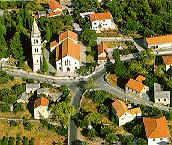

Vrbanj is the biggest village on the island. It dominates the larger part of the valley of Hvar. Its name comes from the word Vrba (willow). Vrbanj is connected with the rising of Hvar 1510-1514, being the focus of it, and the birthplace of its leader Matija Ivanic. In a nice memorial park, in the centre of the village and by the island road, a monument in memory of Fallen Warriors stand.
The square is surrounded with several interesting old houses, among which "Kraljevi dvori" (The Governor's Lodge) is worth mentioning. According to the legend, it is considered to have been the living quarters of Matija Ivanic, even though it was built a great deal earlier, i.e. in the 11th/12th centuries, and thus considered as the quarters of the municipal governor. That is the reason for it being called "Kraljevi dvori".
The parish church of Sv. Duh (the Holy Spirit) today has the characteristics of an 18th century style, even though it already existed in the 15th century. On the high altar there is a painting of "The Descent of the Holy Spirit" by Baldassare d'Anna. The church possesses finely wrought processional candle sticks. Above the village there are the ruins of Romanesque church of Sv. Vid (St. Vitus). The oldest document relating to it dates from 1395.
On the top of the hill Sv. Nikola (St. Nicholas) (626 metres above the sea
level), there is the small church of Sv. Nikola, which was built at the end
of the 15th century by the leader of the popular rebellion Matija Ivanic,
as a symbol of his power.